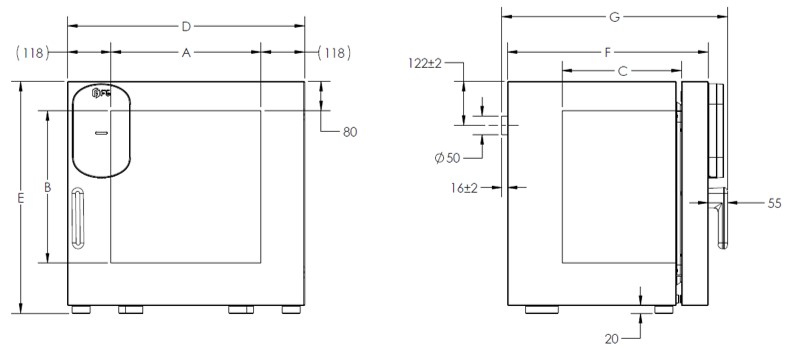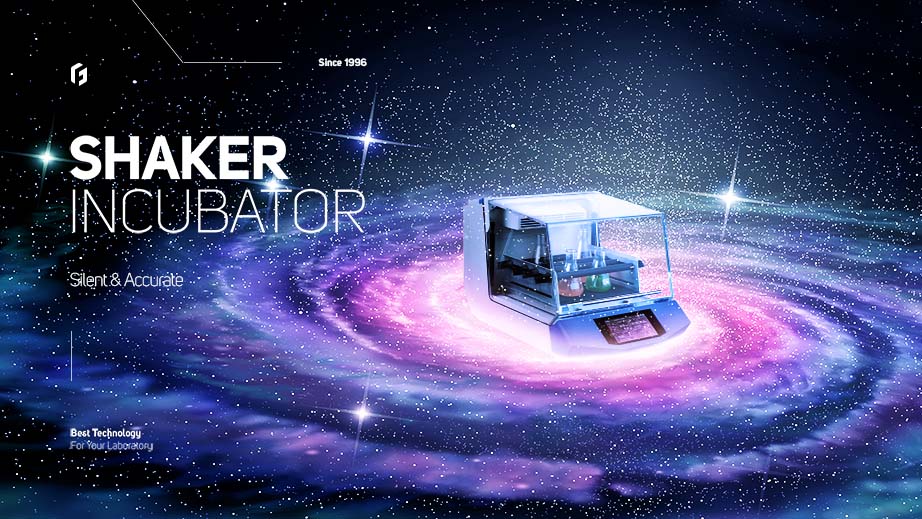HCT (Homogeneous chamber technology)
Temperature stability and reproducibility
Uniformity @ 27 points of chamber
Triple-walled chamber
Fast recovery time
DUAL SAFETY
Class 3.1 independent temperature safety device (DIN12880)
Visual and audible temperature alarm
2 PT100 sensors
Specification of laboratory Oven






Customized equipment and services
Additional stainless-steel rack
Access port with silicone plug
Metal-framed glass doors
Qualification folder IQ/OQ/PQ
Calibration certificate
Interior lighting
External sensor
Rack
Door lock
Laboratory Drying Oven
The laboratory oven is actually a hot air oven that is used for drying, heating, and sterilizing samples and laboratory equipment by the dry heat method. Although the bacterium is destroyed in the high temperature of dry heat, some spores or endospores are only inactive in these conditions and have the possibility of survival.
The suitable temperature for sterilizing and drying cleaned metal instruments using heat in an oven is 180 degrees, for a duration of 2 hours. As the temperature inside the oven gradually increases, the moisture present in glassware will evaporate, resulting in the cessation of any biological activity.
Ovens are usually divided into two groups, with a fan (FORCED CONVECTION) and without a fan (GRAVITY CONVECTION). and include different types of standard ovens and vacuum ovens, and also in terms of size, they are used in different sizes of 55, 120, 240 and 400 liters. are categorized. Ovens are part of fixed laboratory equipment and are used in different laboratories according to the range of facilities and temperature range (up to 300 degrees).
FG Smart laboratory drying Oven, S class.
The FG smart series laboratory oven is an advanced device that provides better performance in the sterilization, drying, and heating of samples and laboratory equipment using new technologies. This device offers reliable and accurate performance to users with smart capabilities such as temperature control, time and other parameters, the ability to connect to the network and remote control, alarm system, and data recording. By using a smart laboratory oven, it is possible to plan and precisely control the sterilization and drying processes in the laboratory. Relying on advanced technologies, this device brings high productivity, saving time and energy. Also, the unique design and beautiful appearance of this device make it a popular choice for laboratories and medical centers.
Types of laboratory oven:
Ovens are generally divided into different types, including laboratory, household and industrial ovens. Types of laboratory ovens usually include standard ovens, vacuum ovens, ovens with fans and ovens without fans and are used in different sizes. In some cases, they are also classified according to the type of body and type of controller and temperature range.
FG laboratory drying ovens are part of the fixed equipment of laboratories and by creating a unique isotherm and uniform temperature in the inner chamber, the high accuracy of the controller for accurate temperature control, also considering the range of facilities and temperature range from 15 degrees above the ambient temperature (up to 300 degrees) for drying, evaporation and sterilization as well as other laboratory operations.
Application of laboratory oven
Ovens in most laboratories, including laboratories of research centers. Medical diagnosis laboratories laboratory of, Pharmaceutical, laboratories factory of Food industry, textile, mines, hospitals, clinics, health centers, universities, etc. are used for sterilizing laboratory containers or dehumidifying samples.
Sterilization in the oven
Aluminum foil or kraft paper and cotton caps can be used to package these devices in order to sterilize them in the oven. Close about 2 cm from the upper end of the pipettes with non-absorbent cotton and place them in metal containers, close the lids, then cover the caps of the test tubes with aluminum paper and place them vertically in the tube holder. The cap protects the tube edge from airborne contamination during storage. Bottles with caps can be sterilized in the oven if their caps and linings are made of materials such as metal, polypropylene, or silicone rubber so that they do not lose their natural shape at the sterilization temperature. Before putting glass containers in it, make sure they are dry. Place the ingredients in such a way that hot air flows around and between them. Sterilization maintenance time starts when the chamber reaches the selected sterile temperature, and some more time is considered until all the parts of the chamber and the materials inside reach the desired temperature (160-180 ۫C for 2 hours).
Laboratory ovens usually have a temperature controller, an air discharge valve (for the release of vapors and gases inside the device) and a timer, which in advanced models such as FG ovens, features such as programming, setting the thermal slope (RAMP) and delay timer (for setting There is also time to turn on the device).
300 degree oven
300 degrees FG laboratory ovens are now produced in two models, BF series with fan and BM series without fan, and in terms of volume, they are produced in 4 models of 55, 120, 240 and 400 liters, which can also be manufactured according to customer needs upon request. The outer body of the oven is made of iron sheet with electrostatic powder paint and the inner housing is made of stainless steel, that giving the device a special beauty. By carefully looking at the inner compartment of the device and observing different angles, we notice the use of curved corners, which makes it easy to clean and safe for the user. On the other hand, the ultra-advanced device controller with the latest microprocessors stands out. The controller of the device using Smart PID algorithms has a significant contribution in temperature control and thermal stability.
The device is equipped with AVR series microcontrollers, which displays the values with the help of a 4-digit digital display. One of the important points of this controller is the use of the PT100 sensor, which has a significant contribution to the accuracy of the device. The PT100 sensor is always known as one of the best and most accurate sensors in the world of electronics.
The FG drying oven has a smart 999-hour timer that turns off the device at the set time by the user. Smart oven means that the timer is activated when the chamber temperature reaches the set point temperature. Also, for the convenience of use, a delay timer is also considered for the device. This timer turns on the device at the set time and allows the user to set the device to turn on during off-peak hours (midnight) without requiring the user and turn off after completing the thermal cycle. This helps in reducing electricity costs and protecting the environment. It is also possible to use this function of FG Ovens to turn on and warm up the device before the user enters the laboratory. Imagine when you enter the laboratory and you don’t need to spend time to warm up the device.
This device is one of the few devices that can be adjusted up to 300 degrees and due to the double insulation of this thermal oven, even when the temperature of the inner compartment of the oven reaches 300 degrees, the temperature of the outer body of the device does not heat up. FG engineers have used the PID controller algorithm to control the temperature in this series of products, which is one of the most accurate control methods in the world. In this method, problems such as OVERSHOOT, temperature fluctuation and non-renewal of temperature are not observed and the temperature of the device remains at the set temperature without fluctuation.
The ability to adjust the thermal gradient is another advantage of FG ovens. In cases where thermal shock is important in the test, you can reduce the heating speed of the device to increase the heating time of the device. The unique central fault finding system is always checking the device and informs the user through audio and visual alarms in case of any problems such as sensor failure. The inner chamber of this oven is the location of the equipment used for humidification, which is often made of stainless steel and resistant to high heat. This compartment is also temperature sensor location.
The heating elements are provided to provide the required heat of the thermal oven and in advanced ovens that are three walls, they are placed in the third wall of the oven to increase the temperature inside the oven to the required amount. Inside each Oven, depending on the type and model of the device, as well as depending on its electrical power, one or more elements are placed. Control and display system of the temperature inside the chamber depending on the type of Oven is used. These two systems can be completely separate or provided in an integrated system. The temperature display system inside the chamber can be a dial thermometer, a mercury thermometer or, in advanced models, an electric board with a thermal sensor and a digital display. Depending on the type of device, the temperature control system can be in the form of metal, mercury thermocouples, or in advanced models of microprocessor systems including precise sensors; In this case, the display and temperature control system can be integrated. Depending on the type of device, electrical and thermal protection systems are provided to protect users and the device and its contents. Electric fuses for cutting the current in emergency cases, the system for cutting the current when the temperature rises too high (when the temperature control system does not work)
One of the important points that should be Noticed when buying a laboratory drying oven is the presence of an air vent in order to ensure the correct operation of the device. Because if the humid air that is created due to the moisture of the samples inside the device is not removed, the drying is not done completely and the user’s test will be difficult. Another important point is creating uniformity in the inner chamber. Because the lack of uniformity between different points of the oven can cause a large temperature difference between different points of the drying oven and thus cause disruption in the test. In this case, a circulation fan can be used to benefit from better uniformity. Of course, it should be noted that the presence of a circulating fan alone cannot cause uniformity. Because various factors such as the fan, the way the element is placed, the way the air circulates and the type of air channel placement and other things have an effect on uniformity. The designers of the E series have clearly tried to meet the needs of a wide range of users along with compliance with international standards, and for this purpose, facilities such as DUAL SAFETY (safety thermostat), unique HCT technology (for uniformity in different parts of the chamber) and also advanced micro controller in this series of ovens.
Unwanted temperature increase is one of the main problems of laboratory ovens, which causes damage to laboratory samples and sometimes huge losses. FG also uses a safety thermostat in line with European standards and always controls the temperature of the device by the second thermostat. In this system, the user sets the temperature of the device by the digital controller and the temperature of the second thermostat a little higher than it, now if the temperature of the chamber rises above the set point temperature for any reason, the second thermostat will control the temperature and prevent the unwanted increase of the temperature of the chamber.
FG has designed HCT technology to create uniformity between different points. While ovens are usually double-walled, by creating a third wall and placing the element in this wall, HCT presents the user with uniformity at 27 points of the chamber. the third wall acts like an air circulation channel and is able to maintain uniformity even in full load mode. Another advantage of technology HCT is the rate of heating and the rate of temperature renewal after opening and closing the device door.
The oven and incubator are completely different and each one is designed for a separate use in the laboratory. But due to their similar appearance, they are sometimes mistaken and cause problems for consumers. The main difference between an oven and an incubator is their application, temperature range, temperature accuracy, and their appearance. For a better review of the difference between these two devices, refer to the article on the difference between an oven and an incubator.
Laboratory oven price
The price of laboratory ovens is different according to its type and size. To buy or to know the price list of FG laboratory oven, please contact FG sales department.
Briefly, the points that we need to know about working with devices such as ovens, incubators, etc. are, first of all, the presence of a ground wire. In case of malfunction or failure of the device, ground connection will reduce the possibility of electric shock by providing less electrical resistance. Failure to properly connect the device to the ground wire will increase the risk of electric shock. Also, you should never turn on the device in a closed and unventilated place. When installing the device, observe the permitted distance from the side devices and the wall. When installing the device, observe the permitted distance from the side devices and the wall. For more information, read the FG laboratory oven catalog as well as the datasheets of this device.
The unique mechanism of the air discharge valve has been created for the maximum discharge of gases and vapors, and its ease of use has won the admiration of users in this field.
- Unique Uniformity with HCT technology
- Double safety to protect your tests against unwanted increase or decrease in temperature
- The ability to adjust the thermal gradient
- High heating speed
- The presence of an adjustable air discharge valve
- Central troubleshooter
- Beautiful appearance and ergonomic design
- Delay timer
- Stainless steel compartment
- Beautiful appearance and ergonomic design
Frequently Asked Questions(FAQ)
According to FG standards and the world’s valid standards, the best distance from the walls, floor and ceiling of the oven is 10% of the length of the same side. For example, if the width of the device is 40 cm, 10% of it means 4 cm on each side (left and right) and if the depth of the device is 50 cm, 10% of it means 5 cm from the front and back, the distance from the walls of the device should be considered for loading.
Yes, with the help of the HCT technology used in the oven, even in the full load mode of the device (according to the principles of loading), you will have full uniformity.
The oven device reaches the set point temperature as quickly as possible and the temperature gradient adjustment is to prolong the time for the chamber temperature to reach the set point temperature, as a result, the time for the chamber temperature to reach the set point temperature cannot be made faster.
Using a safety thermostat in FG devices that works like a fuse and turns off the oven device if the temperature rises above the set point.
It always takes time for the internal chamber temperature to reach the set point. The Smart timer is activated when the temperature reaches the set point.
The cost of changing the color of devices is very high, so it is not cost-effective to do this.
Yes, based on the customer’s order, this feature is available for an additional fee.
The temperature range that is written about ovens, they usually have the ability to control in that range, but they are not very accurate at these temperatures or require changes in the settings of the device. Therefore, for temperatures lower than 80 degrees, usually the best option is an incubator.
No, the mechanism of the air release valve is the maximum exit of vapors and gases created in the chamber. But the circulator fan is used to accelerate the air circulation inside the chamber.
No, if you need more trays in the oven, you can use more space just by buying a tray, and there is no need to install rails or other changes in the device.
Yes, if needed, you can move the trays according to the different drawers installed in the oven.
Yes, a special mechanism has been considered for the air discharge process and the entry of fresh air into the oven chamber, which causes the maximum discharge of moisture and gases created in the chamber.
If you still haven’t found the answer to your question, ask us.
"*" indicates required fields










